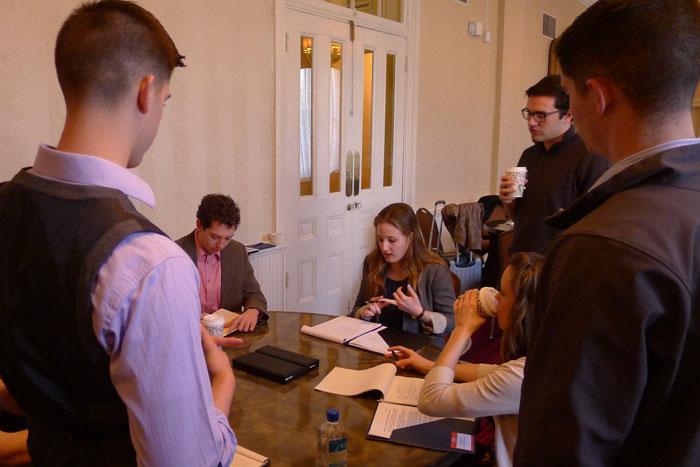Simulated Statecraft

Virginia Cady '15 (seated, center), in the role of OSCE representative, briefs students playing the roles of NATO staff members at a recent Ukraine simulation. Photo courtesy of Ed Webb. (CC-NC-SA)
Students dive in to civilian-military exercise focused on the ongoing situation in Ukraine
by Tony Moore
Head into Google news and search for “Ukraine.” You’ll have to dig pretty deep to find headlines that aren’t something like “Ukraine Crisis Deepens” and “Ukraine Authorities Scramble to Avoid Unrest Flashpoint.” And you’ll need a time machine to find headlines such as “Ukraine: Peace at Last” or “NATO Resolves Ukraine Crisis.”
So as both an academic exercise and an in-the-trenches look at international statecraft, two Dickinson students and one faculty member joined 21 students from five other liberal-arts colleges and six military institutions in Annapolis, Md., for a weekend of discussions, negotiations and compromises in a simulation that explored the diplomatic realities of the Ukraine crisis.
As Real as Possible
The simulation, titled “Ukraine—Alliance Commitments and Strategic Stability,” was held as part of the Mellon Foundation Project on Civilian-Military Educational Cooperation, a project led by Dickinson and directed by Professor of Political Science and International Studies Doug Stuart. The students took on diplomatic and military roles from Germany, the U.S., Estonia, Poland, Russia and Ukraine and served as NATO officials and observers from the European Union and the Organization for Security and Cooperation in Europe (OSCE).
Associate Professor of Political Science and International Studies Ed Webb, who accompanied the two Dickinson students—Anna Leistikow ’15 and Virginia Cady ’15—to Annapolis, served as a diplomat before joining Dickinson’s faculty in 2007. He says that the exercise was built to unfold as real events might on the international stage.
“We give students a briefing packet or a certain volume of information, and then there are what we call injects,” he says. Injects are just that: injections of information for some participants as it emerges over the course of the simulation. “Just like the real world,” Webb says. “You want to make it credible, you want students to be in a space where they can apply what they already know and allow them to really test and apply their existing knowledge and stretch that out in interesting ways.”
Wearing Many Hats
For Leistikow and Cady, both international studies majors, the event was as satisfying as it was challenging.
“This was my first experience with complex negotiations involving so many stakeholders,” says Leistikow, who was assigned the role of German Foreign Minister Frank-Walter Steinmeier. “Considering that it was a real-life issue—something that real political and military leaders are grappling with today—it was really fascinating.”
What she doesn’t mention is that the German delegation was down a member due to illness, so Leistikow also took on the defense minister role and the extra work that came with it. Cady was also handed another part to play at the last minute, and Webb notes that both students took it in stride.
“They had to show a lot of flexibility and initiative,” Webb says. “And they came ready to take it quite seriously, ready to get down to business.”
Cady assumed the roles of both the EU High Representative for Foreign Affairs and Security Policy, Federica Mogherini, and the chair of the OSCE, Ivica Dacic. This role assignation followed the general pattern of this year’s simulation and that of last year: liberal-arts students took on military roles, and their counterparts from military institutions took on civilian roles.
“I ended up focusing on my role as the OSCE chair, as I found it was a more effective way for me to encourage cooperation and talks between the other entities to resolve the problem,” Cady says. “Not only did I gain a better grasp on the issues surrounding the Ukraine crisis, and how incredibly complicated it is, but I learned how difficult these types of negotiations are.”
And negotiations were only part of it. Leistikow at one point found herself representing Germany on the Defense Planning Committee, within NATO, and she had to switch gears and focus on the committee’s specific tasks—wrangling troop counts and mobilization, infrastructure, training and equipment—all in the face of escalating responses.
“Thinking in these granular details about military responses was really tricky, because it was a totally new perspective and set of considerations for me,” she says. “These sorts of discussions are something that senior military leaders work through fairly often, when they’re representing their respective countries in these international forums.”
Connections Made
Having students from disparate environments of higher education—from the likes of Brown, Bard and Vassar to the U.S. Army War College, the U.S. Naval Academy and the U.S. Military Academy—work together aims to narrow the “civilian-military” divide that many see widening across the nation.
“It’s about breaking down those barriers of misunderstanding, or a lack of understanding, and letting these students get to know about each other and talk to each other,” Webb says, noting that the entire Mellon grant is geared toward addressing this issue. “The point is, students are not just learning about international politics; they’re also learning about civil and military education, about each other’s lives.”
“Working with the students from the military academies was not particularly different than discussing issues with the other students from liberal-arts schools,” Cady says. “In fact, there were times when I completely forgot that some of the people in the group were from a military background and others weren’t. I think that testifies to the fact that we all got really into our roles.”
And that immersion didn’t go unnoticed.
“At the end of the weekend,” says Webb, “the director of the simulation, from the Air Force Academy, said, ‘Well, the Dickinson students handled themselves extremely well, just as I’d expect.’ ”
Learn more
- Mellon Grant Ukraine Simulation
- Participating Institutions
- Mellon Foundation Project on Civilian-Military Educational Cooperation
- Department of International Studies
- Department of Political Science
- Latest News
Published April 1, 2015